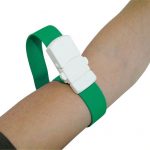 A strap device sometimes used to control severe bleeding of an arm or leg.
A strap device sometimes used to control severe bleeding of an arm or leg.
An instrument or tight bandage wrapped round a limb to constrict an artery, so reducing the flow of blood and stopping bleeding from a wound.
Device, such as a tight bandage or rubber tube, pressed on an artery to stop the flow of blood in a hemorrhage; used only when other measures cannot be used or have not succeeded.
A device used to stop severe bleeding. A tourniquet is usually made from a strong piece of cloth or bandage, wrapped around the blood pressure site nearest the wound but between the wound and the heart, and tightened by tying a knot or twisting it with a stick. Because the use of a tourniquet can be very dangerous, it should be used only when bleeding is life-threatening and uncontrollable by more conservative first aid.
A device to press upon an artery and prevent flow of blood through it, usually a cord, rubber tube, or tight bandage tightened around a limb. Tourniquets are no longer recommended as a first-aid measure to stop bleeding from a wound because of the danger of reducing the supply of oxygen to other tissues (direct pressure on the wound itself is considered less harmful). However, a temporary tourniquet to increase the distension of veins when a sample of blood is being taken does no harm.
A device usually a rubber cord or tight bandage that is bound around a limb to stop temporarily the arterial blood supply and so control severe bleeding. Tourniquets should be applied with caution; unless untied within 15 minutes, gangrene may result, necessitating amputation. Because of this serious hazard, they are rarely used nowadays; direct pressure on the bleeding points is simpler, safer and equally effective in emergencies. A temporary tourniquet to an arm to increase the distension of veins when taking a sample of blood does no harm.
Any constrictor used on an extremity to apply pressure over an artery and thereby control bleeding; also used to distend veins to facilitate venipuncture or intravenous injections.
A device, commonly referred to as a tourniquet, consisting of either a tube or a pressure cuff, is strategically wrapped around a limb to exert pressure and effectively constrict a vein, thereby arresting the flow of blood and preventing further hemorrhaging. The primary purpose of this mechanism is to impede the circulation within the affected area and facilitate immediate control over excessive bleeding. By employing this simple yet indispensable tool, medical professionals can swiftly halt the loss of blood and mitigate potentially life-threatening situations.
A device known as a tourniquet, comprising either a tube or a pressure cuff, is applied firmly around a limb with the purpose of constricting a vein and halting the flow of blood to effectively prevent further bleeding. This technique, widely employed in medical settings, involves the strategic compression of the affected area to swiftly control hemorrhaging and ensure prompt medical intervention. By utilizing this essential tool, healthcare professionals are able to promptly address critical situations involving excessive bleeding and safeguard patient well-being.
A device employed to constrict blood vessels by encircling a limb is known as a tourniquet. Tourniquets are utilized for tasks such as locating veins for intravenous injections or blood withdrawal. An inflatable tourniquet, named an Esmarch’s bandage, serves to regulate blood flow during certain limb surgeries. However, using a tourniquet as a first-aid method to halt severe bleeding can lead to tissue death known as gangrene. Modern first-aid courses now emphasize the use of pressure to manage bleeding, preferring it over the use of tourniquets.
A device designed to stop bleeding from any part of the body by applying direct pressure to the blood vessels using straps, cords, rubber tubes, or pads.
